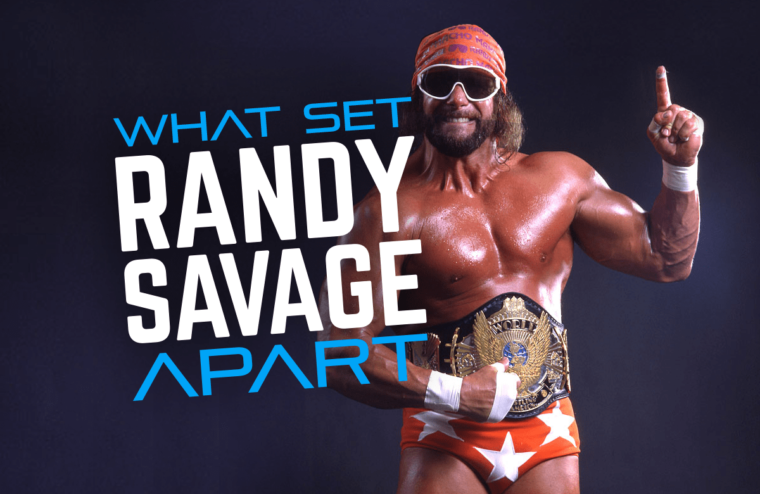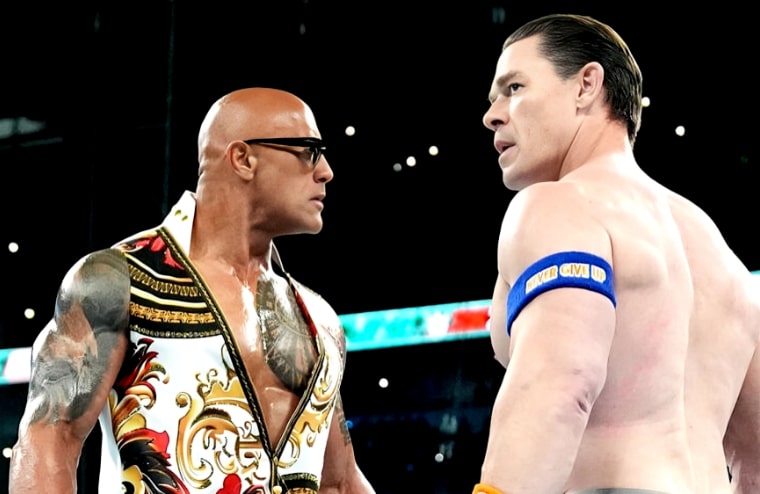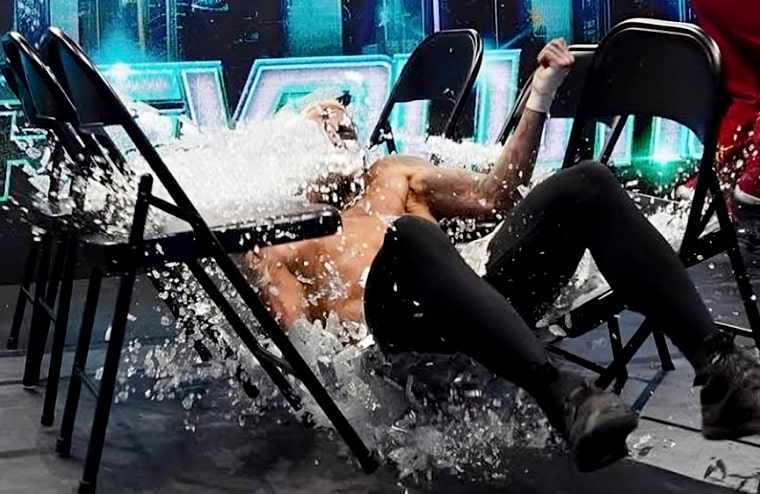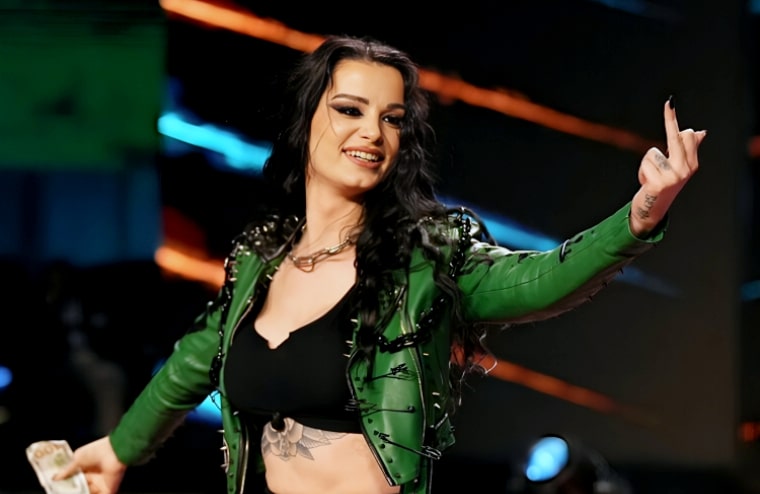“Ohhhh yeah!”
You just read that in Randy Savage’s voice. Don’t be embarrassed, the Macho Man’s classic line is probably one of the most imitated in the history of professional wrestling, and probably ranks pretty high in pop culture as well (although non-fans probably throw in “Snap into a Slim Jim” as part of it). To use an old phrase, Savage has been imitated but never duplicated. In an industry that often sees performers modeling themselves after successful characters from the past, no one has quite managed the mix that gave us one of the most memorable individuals in the last four decades of the business.
His career has been repeatedly reviewed in many different forums, but for those who need an introduction (or a refresher), the next few paragraphs are for you. The rest of you can scroll down, I’ll let you know when to start reading again.
The son of wrestler Angelo Poffo, Randy (his real first name) first focused on baseball, playing in the minor leagues while wrestling a bit in the offseason before focusing on the ring exclusively in the 70’s. He was given the name Savage by Ole Anderson and got the “Macho Man” moniker from his mother, Judy. He main evented shows for his father’s ICW promotion, which ran in competition to the established Mid-Southern promotion in Memphis headlined (as always) by Jerry “The King” Lawler. When his father’s promotion closed, Savage went on to feud with Lawler, ending with Savage dropping a “Loser Leaves Town” match to Lawler in 1985.
Savage signed with the WWF at that point, as Vince McMahon’s company was in the midst of their massive expansion. The first Wrestlemania had been a few months prior, and McMahon’s gamble of making professional wrestling more mainstream had worked. Savage debuted and immediately was positioned as a top challenger for Hulk Hogan’s WWF Championship. Savage was endorsed by top heel Roddy Piper on an edition of “Piper’s Pit”, every top manager vied to represent him on television (only for Savage to instead debut his then-wife Miss Elizabeth as his manager), and the national fascination with “Macho Madness” began.
For almost a decade, Savage was one of the biggest stars in the WWF. His matches with Hogan filled arenas, his Intercontinental Title reign not only elevated the secondary title but culminated in the all-time classic Wrestlemania III match with Ricky Steamboat. He was turned babyface, went on to take the WWF World Championship at Wrestlemania IV and enjoyed a year as the top star (alongside new partner Hogan), headlining shows against Ted DiBiase, Andre The Giant and others before the inevitable turn on Hogan led to him losing the championship to the Hulkster a year later. From there, it was more memorable matches and feuds with the Ultimate Warrior, Jake Roberts, Ric Flair and others, the famed Summerslam wedding to Miss Elizabeth, and through it all he was always one of the top talents in the company.
Things changed in 1994, as the WWF moved away from the iconic stars they had developed in favor of younger talent. Despite getting a huge reaction from the fans when he saved Lex Luger from Bob Backlund on the October 31stedition of Raw (what would be Savage’s last appearance in the company), Vince McMahon felt Savage’s prime was behind him, and wanted to use the Macho Man more in a commentary and goodwill ambassador position. Savage disagreed, and in December of 1994 he moved on to WCW joining his old friend/rival Hulk Hogan (and taking with him a Slim Jim endorsement he had developed that, according to Eric Bischoff, more than covered the cost of signing him to a contract). History has remembered Savage’s five-year WCW run as being less impressive than his WWF run, which is true. Savage was never given the chance to truly headline for the company consistently, and mostly played second-fiddle to Hogan, although he did get his short title runs, main events and had several quality matches with Ric Flair and others.
After losing to the now-evil Hollywood Hogan at Halloween Havoc in 1996, Savage found himself one of many inserted into the New World Order storyline. While many wrestlers got lost in the shuffle of that group, Savage managed to find an opportunity to stand out with an incredible series of matches with Diamond Dallas Page throughout 1997. Those matches not only elevated Page into stardom (since Savage, unlike some of his contemporaries, actually put over opponents), it showed that Vince McMahon had been wrong. Savage still had plenty left in his tank. Unfortunately, Savage was as much a victim of WCW’s late 90’s erratic booking and ego battles as anyone else and after a May 2000 appearance on an episode of Thunder where he joined forces with Ric Flair and Hulk Hogan as part of the Millionaire’s Club, Savage disappeared off the wrestling scene. While WCW crumbled and WWF won the wrestling war, Savage was nowhere to be found.
A return to the WWF never happened for reasons that only Savage and Vince McMahon know (and no, I’m not entering into all the ridiculous speculation that has gone on for years about the reasons why). Instead, Savage turned to other projects, including an acting career that saw him appear as wrestler Bonesaw McGraw in 2002’s Spider-Manand doing voice work for Disney’s 2008 film Bolt. His only involvement in wrestling was his bizarre rap album in 2003 (yes, I said rap album) where he called out Hulk Hogan on a track entitled “Be A Man” accompanied with a grandstand challenge to fight him “for real” for charity… oh, and that TNA appearance. Yes, Savage’s last “match” took place in December 2004, teaming with Jeff Hardy & AJ Styles vs. Jeff Jarrett, Kevin Nash & Scott Hall where Savage was barely involved, barely did anything on his way to pinning Jarrett for the win, and is now (thankfully) barely remembered, as Savage never appeared for the company, or any company, again. Shortly before his death in 2011, when he suffered a heart attack while driving, Savage had done appearances for WWE’s toy and video game licensees, leading many to believe an appearance with the company was inevitable. However, it never happened.
Okay, those of you who were looking to skip the career recap, you can start reading again here.
So, it is 2019. 25 years after his celebrated WWF run. 19 years after his last appearance for WCW. 15 years after his last “match” with TNA. Eight years after his death at age 58. Yet, I look around, and I still see Randy Savage. Images, match clips and interview segments have become a popular source of GIF and meme material in social media (just do a search and see how many come up). Retro merchandise of his is worn, not just at wrestling shows, but everywhere. WWE NXT star Velveteen Dream has a t-shirt in the same purple color and style of Savage’s mega-selling 80’s shirt. Top performers such as Jay Lethal and CM Punk have paid tribute to Savage with their versions of his interviews, ring gear and elbow drop finisher. Fans far too young to have seen him wrestle (in fact, some born after his last WCW appearance), know who he is, celebrate his matches, and (of course) imitate his voice.
Why? What is it about Savage…. and why has no one managed to truly lock into what made him stand out from a crowded era of memorable personalities? Here are a few thoughts as to perhaps why Macho Madness still exists.
A unique story shrouded in privacy. There is an air of mystery around Savage as a result of his desire to keep everyone at a distance. While Hulk Hogan and the Ultimate Warrior aired their dirty laundry for the world to see, and other 80’s and 90’s stars have spilled their guts in numerous “shoot” interviews, Savage never opened his world in that way to the general public. The closest we came were some bragging rants and interviews when he was promoting his 2003 rap album (and I would strongly argue those were not “shoots” but rather attempts at publicity). His brother, Lanny Poffo, has been our only real connection to Savage’s thoughts, and even he has stated that he doesn’t know what his brother was thinking all the time. While many wrestlers cashed in after the business was “exposed” to the world with behind-the-scenes tales, Savage never did.
Randy Savage never trusted the media, and as a result, we don’t have a tell-all about him. To say he was paranoid about what people would write about him is not a stretch. I interviewed Savage a few times in conjunction with him promoting his rap album for 1Wrestling.com, and also was the first to interview him following the passing of Elizabeth in 2003. In order for the interview to be allowed, I had to record our conversation, transcribe it, and submit it via email to Savage to be “approved.” After that, I had to make any changes Randy wanted to his answers, resubmit it to him again, and then after his final approval, the interview could be posted. Savage was pleasant and personable during our conversations, but he had to have full control over what was being put out.
The lack of access he gave, combined with his popularity, and the fascination over his relationships with Miss Elizabeth (as evidenced by the popularity of the Viceland episode “The Match Made In Heaven” earlier this year) and Hulk Hogan (I think the word “frenemy” was invented for them) makes Savage a intriguing mystery. Often, the unknown is more appealing to the public, because it allows people to constantly speculate, draw conclusions, then speculate some more, since the answers will never come out.
There was no decline. Name a bad Randy Savage match. Okay, besides that TNA Victory Road match. That doesn’t count. If you can think of one, was it bad because of Randy Savage’s performance? I asked myself this question and immediately thought about the craptacular Uncensored 1996 “Tower of Doom” match with Savage & Hogan beating eight men… but that wasn’t bad because of Savage. It was bad because of ridiculously confusing booking. There may have been some less than stellar bouts towards the end of his WCW run, but for the most part, you can’t think of bad Savage matches. Even when put in situations where he couldn’t have a Steamboat-Savage classic, the Macho Man still delivered. Unlike other 80’s headliners, Savage doesn’t have a history of declining match quality as a result of too many comeback attempts.
Intensity. The one word that has constantly popped into my mind as I worked on this column is intensity. Watch Savage’s matches and he never loses that look in his eyes. Even when applying what would be referred to as a “rest hold” during a bout, Savage still has a face that is a strange mix of focus and volatility. He knows exactly what he is doing in the ring, but at any moment you feel he could explode. You expect that intensity when wrestling the main event with Hulk Hogan, Ricky Steamboat, Ultimate Warrior or Ric Flair… but Savage had it when parading as the “Macho King” and doing comedy matches with Dusty Rhodes. Savage had it when bumping around a past-his-prime Andre The Giant during 1988 title defenses. Savage had it during squash matches when he first appeared on television. In his classic interviews, even when delivering ridiculously comical lines (prior to a lumberjack match with Hulk Hogan, I recall him walking onto the interview set with a plank of wood and punning that he was “bored/board” with Hogan), he still never seems to relax. It was always there.
For all of the influence he has had on the current generation of performers, I don’t think I have ever seen one that always appears to be “on” the way Savage is. Ultimately, it might be that intensity that draws us to Savage the most. You can imitate the voice, you can copy the look, you can climb to the top rope and drop an elbow, but the mixture that created Macho Madness was unique to Randy Savage. In a world where fans are constantly looking for the “next Hogan” or the “next Flair” or the “next Austin,” no one is looking for the “next Savage” because we’re still thinking about the original… and no one has come close to matching it yet.
A huge thank you to everyone for their feedback and comments regarding last week’s column, “The Good, The Bad and The Ugly: More (And More) Wrestling At Your Fingertips.” For those that missed it, you can still check it out in the Pro Wrestling section here at WebIsJericho.com
- The ECW Matches We Didn’t Get: Shane Douglas vs. Brian Pillman - May 8, 2021
- The ECW Matches We Didn’t Get: Public Enemy vs. Bubba Ray & D-Von Dudley - April 14, 2021
- The ECW Matches We Didn’t Get: Mike Awesome vs. Rob Van Dam - April 4, 2021




